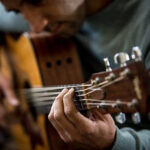The question always arises: “Why play video game instruments when you could just form a real band?” It’s a fair point at first glance when discussing games like Guitar Hero World Tour and Rock Band. However, dismissing these titles with such a question fundamentally misunderstands their appeal and the unique experiences they offer.
While satire like the South Park episode “Guitar Queer-o” playfully mocks the hype around rhythm games, the reality is that Guitar Hero World Tour, with its expanded instrument set including drums and microphones, opened doors for many to experience the joy of making music with friends, regardless of resources or prior musical experience. This accessibility is undeniably a positive aspect.
Compared to typical video games, Guitar Hero World Tour fostered a sense of musical community and collaboration. It wasn’t always about head-to-head competition, but about rocking out together. It offered a fun and engaging gateway into the world of music.
Setting Up Your Band: Instruments and Gameplay
Building upon the foundations of previous Guitar Hero games, World Tour introduced a full band experience. Let’s dive into the instruments:
Drums: Enhanced and Quieter
The drum kit in Guitar Hero World Tour was a significant step up in design and functionality. Activision clearly learned from the existing Rock Band drum kit, creating a sturdier and more thoughtfully designed instrument. One common frustration with the Rock Band kit was accidental pausing during intense drumming sections, a problem largely addressed in World Tour. Parents and roommates will also appreciate the quieter operation of the World Tour drums. The kick pedal felt more realistic despite its plastic construction, and the addition of an extra cymbal provided a welcome layer of challenge for aspiring drummers looking to hone their skills.
Vocals: A New Challenge for Frontmen (and Women)
The vocal gameplay in Guitar Hero World Tour took a different approach compared to Rock Band. While Rock Band allowed players to simply tap the microphone in rhythm during instrumental sections to boost the band’s score, World Tour required vocalists to actually “vamp” or improvise. This could be fun if you knew the song well, allowing for creative vocal fills, as exemplified by the vocoder section in “Living on a Prayer.” However, for unfamiliar songs, it could be a tougher challenge for the band’s overall performance. And for the truly brave (or foolish), attempting to sing System of a Down’s “One Arm Scissor” was presented as a particularly brutal vocal trial.
Guitars: Familiar and Reliable
In terms of guitar controllers, Guitar Hero World Tour didn’t deviate drastically from Guitar Hero III. The core gameplay remained familiar and solid. While the tobacco sunburst finish on the new Fender-style bass controller might not have appealed to everyone, the functionality and feel remained consistent with previous iterations. Customizable faceplates were also likely offered, allowing players to personalize their instruments.
The Soundtrack: A Mix of Rock and Pop Sensibilities
Song selection is often a critical point of comparison between music games. The original reviewer felt Rock Band had a stronger initial song list with more definitively “rocking” choices, citing bands like Weezer, Ramones, and The Who. Guitar Hero World Tour, in contrast, was perceived as having a softer, more mainstream appeal with artists like Coldplay, Bob Seger, Lenny Kravitz, and Wings.
However, Guitar Hero World Tour did include heavier tracks from artists such as At the Drive-In, Tool, and Metallica, demonstrating a range across genres. The broader song selection in World Tour was likely a strategic move for wider market appeal, especially during the holiday season. The inclusion of artists like Steely Dan, The Eagles, and The Doors made the game more accessible to a wider age range, potentially appealing to families playing together.
Both Guitar Hero World Tour and Rock Band expanded their music libraries significantly through downloadable content. Guitar Hero World Tour also uniquely offered a built-in music studio, allowing players to create and share their own songs online for free. While the quality of user-generated content could be variable, the potential for discovering fan-made tracks of favorite bands was a significant draw.
Graphics and Immersion: A Step Up in Visuals
Graphically, Guitar Hero World Tour offered a subtle but noticeable improvement over Guitar Hero III and was considered visually superior to Rock Band. Character customization options appeared more detailed and integrated better with the cartoonish aesthetic of the game. Characters in Rock Band were described as appearing comparatively static. While the crowds in World Tour were more visually engaging, the reviewer suggested further enhancements like stage diving, moshing, and crowd surfing to enhance the sense of a live concert experience, features perhaps hoped for in future iterations.
Final Verdict: World Tour vs. The Competition
Rock Band pioneered the full band concept and garnered significant acclaim. However, Guitar Hero World Tour arrived as a refined and polished competitor. With similar pricing at launch, Guitar Hero World Tour was positioned to potentially outperform Rock Band in sales, based on its enhanced instrument design, improved graphics, and broader song selection. The conclusion was that Rock Band would need to innovate and elevate their game to maintain its competitive position in the face of Guitar Hero World Tour‘s strong challenge.

